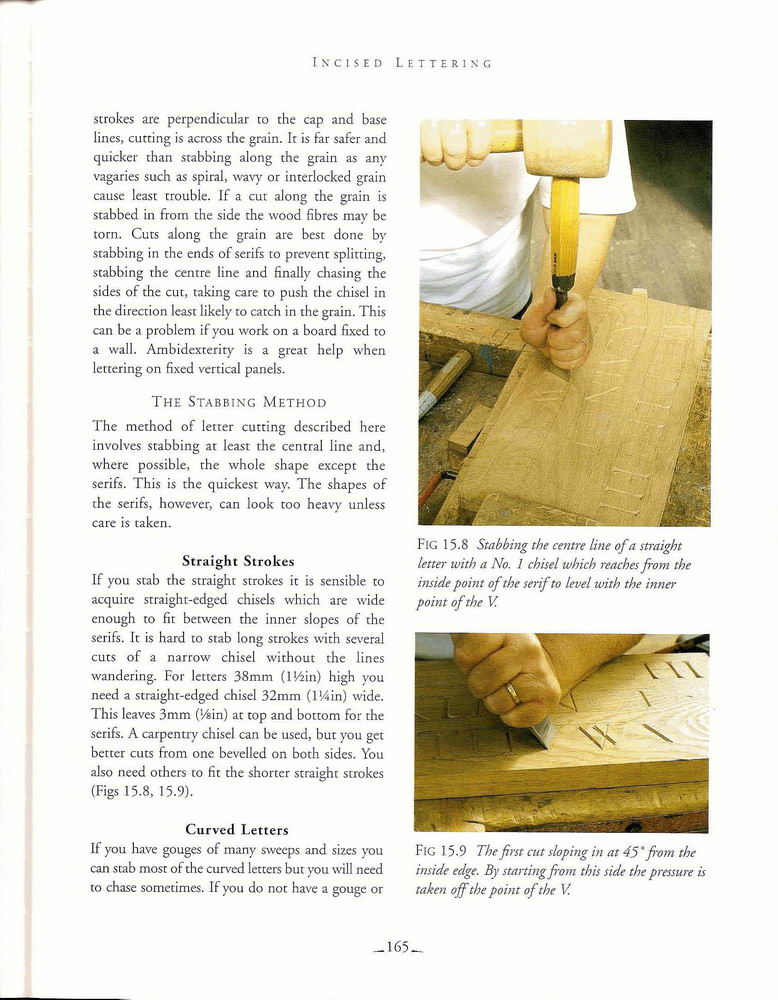essentÊrving±65

INCISED LETTERING
scrokes arc perpcndicular to che cap and base lines, curring is across che grain. It is far safcr and Ä…uicker chan stabbing along the grain as any vagaries such as spiral, wavy or interlockcd grain cause least croublc. If a cut along the grain is stabbed in from the side the wood fibres may be torn. Cuts along the grain are best done by stabbing in the ends ofserifs to prevent splitting, stabbing the centre linÄ™ and finally chasing the sides of the cut, taking care to push the chisel in rhe direction least likely to catch in the grain. This can be a problem if you work on a board fixcd to a wali. Ambidexterity is a grcac help when lettering on fixed vertical panels.
The Stabbing Method
The method of letter cutting dcscribed here involves scabbing at least rhe central linÄ™ and, where possible, the whole shape except the serifs. This is the quickest way. The shapcs of che serifs, howcver, can look too heavy unless carc is taken.
Straight Strokcs
If you stab the straight strokcs it is sensible to accjuire straight-edged chisels which are wide enough to fit between the inner slopes of the serifs. It is hard to stab long strokcs with several cucs of a narrow chisel without the lines wandering. For letters 38mm (P/^in) high you need a straight-edged chisel 32mm (l!4in) wide. This leaves 3mm (V6in) at top and bortom for the serifs. A carpcntry chisel can be used, but you get bettcr cuts from one bevelled on both sides. You also need others to fit che shortcr straight strokes (Figs 15.8, 15.9).
Curved Letters
If you have gouges of many swccps and sizcs you can stab most of the curved letters but you will need to chase somctimes. If you do noc havc a gouge or

FlG 15.8 Stabbing the centre linÄ™ of a straight letter with a No. I chisel which reaches from the inside point of the serif to level with the inner point of the V.

FlG 15-9 Thefirst cut sloping in at 45“from the inside edge. By startingfrom this side the pressure is taken off the point of the V.
— 165 —
Wyszukiwarka
Podobne podstrony:
essent?rving?63 INCISED LeTTERINC, Agcs, and V was used until then. The Frcnch still cali W double V
essent?rving?67 INCISED LeTTERING the centre chan dcsired. The sides of the tool may need co be grou
Name: Number: DatÄ™: 1- Match each picturc to its namc and paint thcm. This is a pink dress. This is
critical care HARRY KRAUS, MD Bf U-$( U ING AU TMO« "Finally, a rc**on to tum olf and Gfiry i A
as (8) This ring is a snap to work up. and no one will befceve ihat you madÄ™ it us*ng hairpin c
smpb 05 A PersonalMessage from CHARLES ATLAS Dirrclor of Ikr FAMOUS ATLAS SYSTEM gpOSOMUl Pil To che
exam0004 2. Reading A You arc going to read a magazine article about an English woman living in Pari
162 Marcia Narożnik arc obliged to relinquish thcir posts. If an int.cn.al in cxccuting functwci doc
190 Zhtgnie w Kmieciak mcans that ihcsc agcncics arc cntitlcd to issuc indivjdual administrativc act
LettersSpeaker Distorted I am pleased to sce in your magazine my com-menis on loudspeakcr design cnt
About User Privileges and Roles User privileges provide a basie level of database security. Thcy arc
Spawanie elektrodami otulonymi (MMA- Manuał Metal Arc Welding) to najstarsza i najbardziej uniwersal
10. Letter from Amurath III to thc States of Poland; Latin; lunÄ™ 15, 1587. MS
75 (16) paciicc tatnng. jcuYe likcly to cod v.«halotofbcts and n tłut arc not usab!c
więcej podobnych podstron